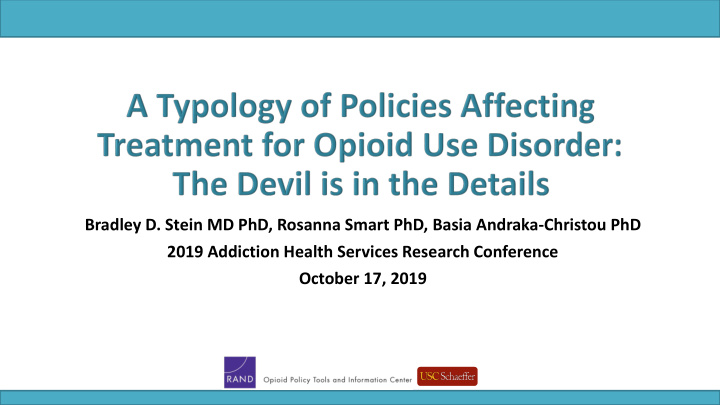



Bradley D. Stein MD PhD, Rosanna Smart PhD, Basia Andraka-Christou PhD 2019 Addiction Health Services Research Conference October 17, 2019
• Grateful for support from the • Colleagues I would like to National Institute on Drug acknowledge Abuse of the NIH • Megan Schuler, PhD • All views and opinions • Mary Vaiana, PhD expressed are my own, not • Rosalie Liccardo Pacula, PhD NIDA’s • Sean Grant, PhD • No conflicts of interest
• What is a policy typology? • Why do we need one for opioid treatment policies? • How does using a typology calibrate (or help recalibrate?) our research efforts?
• Treatment for opioid use disorder (OUD) is essential to the national response to opioid crisis • Medication treatment is the gold standard, but • only 10%-20% of individuals who need it receive it • quality of treatment uncertain • We need to better understand more precisely how policies affect access to and quality of OUD treatment
• Treatment for opioid use disorder (OUD) is essential to the national response to opioid crisis • Medication treatment is the gold standard, but • only 10%-20% of individuals who need it receive it • quality of treatment uncertain • We need to better understand more precisely how policies affect access to and quality of OUD treatment When I say “state and federal policies” affecting OUD treatment what policies do you think of? What exactly are we studying?
• Raising buprenorphine patient limits and expanding to PA/NP • Increasing coverage and reimbursement • Efforts to support buprenorphine prescribing (hub & spoke) • Some non opioid-specific policies • Medicaid expansion • NP Scope of practice regulations • Policies targeting specific populations — e.g. • pregnant women • incarcerated individuals
• Prior authorization • Limits on treatment duration and lifetime episodes • Counseling requirements for buprenorphine prescribing • Low reimbursement rates • Medicaid work requirements
• Typology: classification based on categories with different attributes • Typology of treatment policies: a framework for understanding specifically what policies are intended to do, and how • Just listing policies subject to heuristic biases- recall, anchoring, conceptualization of the crisis • Typology makes systematic omissions less likely • Increases recognition of complexity, importance of policy components, role of concurrent policies • Facilitates more precise consideration of likely effects and unintended consequences
• Rosanna Smart leading OPTIC work in multiple opioid policy areas: harm reduction/naloxone, OUD treatment, opioid analgesic prescribing • Policies can target different activities to reach the same goal (example of reducing opioid analgesic misuse) • Policies could involve reducing opioid analgesic prescribing, preventing doctor/pharmacy shopping, reformulating oxycontin • For any given goal, policies can use different approaches • Reducing opioid analgesic prescribing: prescription duration limits, required education, EHR modifications, PDMP
• Type (area) of treatment most influenced by the policy? • All types of OUD treatment • Non – pharmacologic treatment • Medication treatment • Buprenorphine • Methadone • Naltrexone • Setting/comprehensiveness of treatment? • Specialty substance abuse • Primary care • Health homes/ACOs
• Entire community – policies that influence community treatment capacity such as waiver trainings, hub and spoke, scope of practice laws? • Medicaid enrollees? • Expanding population who can receive services (ACA, presumptive eligibility) • Coverage for medication or services • Specific high-risk or underserved populations? • Incarcerated/formerly incarcerated individuals • Pregnant women • Adolescents
• Provider behavior with patients? • Community/contextual • reimbursement rates changes? • • prior authorization scope of practice laws • • counseling requirements Medicaid eligibility • • patient monitoring zoning restrictions for OTP • infectious disease screening • Patient behavior? • copayments/coinsurance • take home/mobile methadone • urine drug screens
Accounting for Defining and Modeling policy the dynamic categorizing effects crisis & policy policies environment
• Continue to develop typology/ taxonomy for opioid policies • Apply these frameworks analytically • Use in empirical studies to help identify and address most likely potential confounding policies • Ensure our research is thoughtful about range of policies and policy components/mechanisms we need to examine. • Track how state policies focused on the opioid crisis are evolving • Identify which areas are receiving greater – or less – attention
stein@rand.org https://www.rand.org/optic 15
Recommend
More recommend